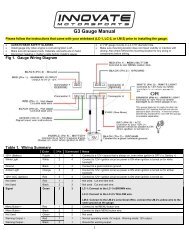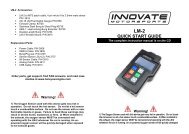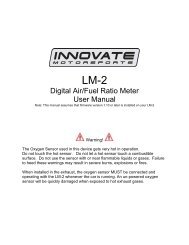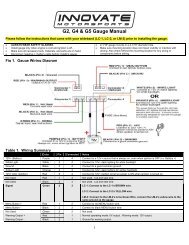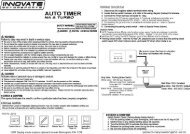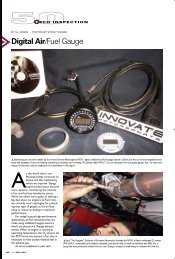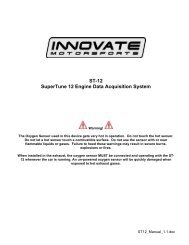Digital Air/Fuel Ratio Gauge User Manual - Innovate Motorsports
Digital Air/Fuel Ratio Gauge User Manual - Innovate Motorsports
Digital Air/Fuel Ratio Gauge User Manual - Innovate Motorsports
You also want an ePaper? Increase the reach of your titles
YUMPU automatically turns print PDFs into web optimized ePapers that Google loves.
5.6 Connecting the MTX-L to simulate a narrow band oxygen sensor<br />
It is possible to install the wide-band sensor in place of the OEM oxygen sensor. In this<br />
case the meter's analog output signal will replace the OEM oxygen sensor's signal to<br />
the fuel injection computer. Note: Please review your analog output settings; the<br />
configuration for a narrowband is 1.1 V for an AFR of 14 and .1 V for an AFR of 15.<br />
EFI equipped cars typically incorporate a narrow band oxygen sensor. These sensors<br />
are typically 1, 2, 3 or 4 wire sensors. Some vehicles are equipped with oxygen sensors<br />
that do not produce an output voltage but change their resistance depending on exhaust<br />
gas content. These sensors cannot be simulated. They are used in less than 1% of all<br />
vehicles. Refer to your vehicles specifications if you think that your vehicle may be in<br />
this category. The same is true for vehicles already factory equipped with a wide-band<br />
oxygen sensor. These cannot be simulated either.<br />
Some EFI-computers will create a fault when the heater power wires of the oxygen<br />
sensor are disconnected. In this case mount the old oxygen sensor in a safe place (but<br />
not necessarily in the exhaust) and connect the heater wires to it to keep the EFIcomputer<br />
happy.<br />
Be careful where you mount the stock sensor, as heated sensors will get hot.<br />
To connect the MTX-L to the EFI-computer, first determine what kind of narrow band<br />
sensor is used, then follow the instructions below (you will need a digital multimeter to<br />
determine correct OEM sensor wires):<br />
a. Vehicle has a 1-wire sensor:<br />
Wire analog output 1 directly to the wire.<br />
b. Vehicle has a 2-wire sensor:<br />
While the engine is off determine which of the 2 wires has a low resistance between the<br />
wire and the sensor body. This is the heater power for the sensor. Wire analog output 1<br />
directly to the other wire. Leave the heater power wire unconnected but make sure it<br />
cannot ground itself.<br />
c. Vehicle has a 3-wire sensor:<br />
Typically the 3 wires are: heater power, Ground, and sensor element connection.<br />
Generally they have 1 black wire and 2 white wires. Connect the black wire from the EFI<br />
computer to analog output 1 of the meter. Leave the other wires unconnected but make<br />
sure they cannot contact any metal parts or see above. If the wiring colors are different,<br />
then heater power can simply be determined by measuring the voltage on the wires<br />
when the engine is running. The wire showing 12V or more is the heater power. The<br />
sensor element connection voltage fluctuates around 0.45V when the car is warmed up.<br />
15<br />
Document #<br />
MTX-L_<strong>Manual</strong>.doc





